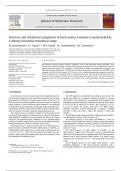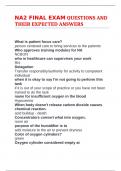Journal of Molecular Structure 997 (2011) 117–125
Contents lists available at ScienceDirect
Journal of Molecular Structure
journal homepage: www.elsevier.com/locate/molstruc
Structure and vibrational assignment of bis(4-amino-3-penten-2-onato)nickel(II).
A density functional theoretical study
M. Jamialahmadi a, S.F. Tayyari b,⇑, M.H. Habibi c, M. Yazdanbakhsh a, R.E. Sammelson d
a
Chemistry Department, Ferdowsi University of Mashhad, Mashhad 91775-1436, Iran
b
Department of Chemistry, Neyshabur Branch, Islamic Azad University, Neyshabur, Iran
c
Department of Chemistry, University of Isfahan, Isfahan 81746-73441, Iran
d
Department of Chemistry, Ball State University, Muncie, IN 47306-0445, USA
a r t i c l e i n f o a b s t r a c t
Article history: Bis(4-amino-3-penten-2-onato) nickel(II), (Ni(APO)2), and its NH deuterated analog, Ni(DAPO)2, were
Received 27 January 2011 synthesized and their molecular structure and vibrational assignments were investigated by means of
Received in revised form 4 May 2011 density functional theory (DFT) calculations. The molecular stability was investigated by applying the
Accepted 5 May 2011
NBO and geometry calculations. The harmonic vibrational frequencies of Ni(APO)2 and Ni(DAPO)2 were
Available online 11 May 2011
obtained at the B3LYP level using 6-311G⁄ basis set. The calculated geometrical parameters and vibra-
tional frequencies were compared with the experimental results. The measured vibrational band fre-
Keywords:
quencies were interpreted in terms of the calculated vibrational normal modes. The scaled theoretical
Bis(4-amino-3-penten-2-onato)nickel(II)
FT-IR spectroscopy
frequencies and the structural parameters were found to be in good agreement with the experimental
FT-Raman spectroscopy data.
Vibrational assignment Ó 2011 Elsevier B.V. All rights reserved.
Density functional theory
1. Introduction 2. Experimental
In recent years, the use of amine and imine complexes based on The APO ligand was synthesized according to Lacey [12]. This
late transition metals as active and selective catalysts for the poly- ligand was added to an aqueous solution of nickel (II) acetate
merization of a-olefins has received a great deal of attention [1–7]. and Ni(APO)2 was obtained as a precipitate. This precipitate was
The late transition metal complexes, because of their less oxophilic purified by crystallization from a chloroform solution. Anal. Found:
nature relative to early transition metal complexes, are generally C, 47.52; H, 6.42; N, 10.66; Ni, 23.19 Calc.: NiC10H16O2N2: C, 47.11;
considered to be more tolerant toward polar media and polar func- H, 6.33; N, 10.99; Ni, 23.02%. M.p. 245 °C, 1H NMR (CDCl3,
tional groups and thus make them possible targets for the develop- 100 MHz, reference: solvent residual peak, d 7.24 ppm): d 9.66(b,
ment of catalysts for polar monomer polymerizations [5,8]. 2H, NH), d 4.83(s, 2H, CH), d 1.84(s, 6H, CH3CO), d 1.58(s, 6H,
Ni is known to be an excellent catalyst for many processes. He CH3CN).
and Wu [9] synthesized and characterized a series of bis(b-ketoa- The NH deuterated analog of Ni(APO)2, referred to as Ni(DAPO)2,
mino)nickel(II) complexes and investigated the effects of catalyst was prepared according to the literature [13].
structure and polymerization conditions on the polymerization The infrared spectra in the region 500–4000 cm 1 were re-
activity of methyl methacrylate using bis(b-ketoamino)nickel(II)/ corded on a Bomem MB-154 Fourier transform spectrophotometer
methylaluminoxane (MAO) as catalytic systems [10]. using KBr pellets and CHCl3 and CH2Cl2 solutions. The spectra were
According to Gurr’s study [11], the unit cell of bis(4-amino-3- collected with a resolution of 2 cm 1 by signal averaging the re-
penten-2-onato) nickel(II) [hereafter abbreviated as Ni(APO)2], is sults of 15 scans.
orthorhombic, space group Ccca, and the unit cell dimensions are The Far-IR spectra of CsBr pellets of Ni(APO)2 in the
a = 16.7, b = 15.1, c = 13.5 Å. In this research, the complex was pre- 600–150 cm 1 region were obtained by using a ThermoNicolet
pared in high purity and experimental data were compared with NEXUS 870 FT-IR spectrometer equipped with a DTGS/polyethylene
the theoretical calculation results. detector and a solid substrate beam splitter. The spectra were
collected with a resolution of 2 cm 1 by averaging the results of 64
scans.
The FT-Raman spectra in the region 3200–200 cm 1 were
⇑ Corresponding author. Tel.: +98 9153103538. recorded employing a 180° back-scattering geometry and a
E-mail address: sftayyari@hotmail.com (S.F. Tayyari). Bomem MB-154 Fourier transform Raman spectrometer operating
0022-2860/$ - see front matter Ó 2011 Elsevier B.V. All rights reserved.
doi:10.1016/j.molstruc.2011.05.008
, 118 M. Jamialahmadi et al. / Journal of Molecular Structure 997 (2011) 117–125
at the 1064 nm excitation line of a Nd:YAG laser. It was equipped Table 1
with a ZnSe beam splitter and a TE cooled InGaAs detector. Ray- Selected experimental (X-ray) and calculated geometrical parameters for Bis-(4-
amino-3-penten-2-ono)nickel(II) (bond lengths in Å, bond angles in °).
leigh filtration was afforded by a set of two holographic technology
filters. The spectra were accumulated for 2500 scans with a resolu- Parameter Ni(APO)2 X-ray Ni(acac)2a APOb
tion of 2 cm 1. The laser power at the sample was 500 mW. Bond lengths Cis Trans
NiAO 1.865 1.853 1.845 1.876
NiAN 1.859 1.857 1.843
3. Method of analysis OAC 1.274 1.287 1.337 1.273 1.238
NAC 1.318 1.306 1.299 1.348
All the computations in the present study were performed using C9AC10 1.406 1.420 1.405 1.401 1.445
GAUSSIAN 03 software package [14] and NBO 5.0 [15] programs. C7AC10 1.395 1.385 1.342 1.375
C6AC14 1.511 1.510 1.475 1.504 1.522
The geometry optimization and vibrational frequencies are per-
C8AC16 1.513 1.512 1.536 1.505
formed at the B3LYP level using 6-311G⁄ basis set. NAH 1.014 1.014 0.796 1.005
Raman activities were computed by numerical differentiation of C14AH 1.091 1.091 0.960
dipole derivatives with respect to the electric field, using standard C11AH13 1.081 1.083 0.961 1.083
GAUSSIAN 03 procedures (Freq = Raman) and default options. Bond angles
Vibrational assignments are based on comparison of calculated O2ANiAO3 84.66 179.58 85.30 93.6
O2ANiAN5 176.8 93.37 178.0
and observed Raman and IR frequencies and activities. The pro-
O2ANIAN4 92.17 86.63 94.33
posed assignments are further corroborated by noting the deute- N4ANiAN5 90.99 179.83 86.11
rium isotopic shifts of different bands and their predicted shifts O2AC6AC11 124.99 125.56 123.87 123.5
by the same theoretical methods. The assignment of the calculated O2AC6AC14 114.71 114.03 116.05 119.5
wavenumbers is aided by the animation option of the GaussView N4AC8AC11 122.83 121.83 123.76 122.4
N4AC8AC16 118.45 120.07 116.97 116.0
3.0 graphical interface for Gaussian programs [14,16], which gives
C16AC8AC11 120.30 120.41 120.03 121.6
a visual representation of the shape of the vibrational modes. C6AC11AC8 122.33 123.01 124.37 123.1
NiANAH 118.52 114.86 121.45
CANAH 112.62 116.12 111.39
4. Results and discussion C8AC11AH13 118.62 118.77 118.20 118.2
H4AN4ANiAN5 0.72 2.74
O2ANiAN5AH5 0.5
4.1. Molecular geometry
H17AC17AC9AN5 158.022 2.752 129.43
HAC14AC6AO2 179.020 179.729 156.37
According to the theoretical DFT calculations, two configura- c
DEgas 27.45
tions are possible for Ni(APO)2. These are recognized as trans and DEsolution 13.07
cis configurations and are shown in Fig. 1. The optimized geomet- a
Data from [21].
rical parameters of trans Ni(APO)2 are summarized in Table 1. The b
Calculated at B3LYP/6-311G⁄.
theoretical calculations in the gas phase indicate that the trans c
DE = Ecis ETrans in kJ mol 1.
configuration is considerably more stable than the cis configura-
tion (about 27.45 kJ mol 1), which is not in agreement with the
X-ray result of Gurr [11]. According to the X-ray crystallography, 14.4 kJ mol 1), compared to that in the gas phase. Unfortunately
the cis configuration is prominent. This is most likely due to the ne- there is no way to predict the energy difference in the solid state.
glect of solvent effects in our theoretical calculations, which is cer- However, this large energy shift may be consistence with the lower
tainly important (but not easily incorporated) for Ni(APO)2 energy of the cis form in the solid state.
complex systems [17,18]. However, Bradbury et al. [19] have As it is shown in Table 2, the calculated bond lengths of CAO
shown that Ni(APO)2 is predominantly trans in solution with the and C7AC10 are longer and CAN and C9AC10 are shorter than the
cis and trans isomers in rapid equilibrium at room temperature, corresponding values in APO. This results show that the resonance
therefore both vibrational frequencies and molecular geometry is in Ni(APO)2 has increased relative to APO. The calculated NiAO dis-
dependent on the chemical environment. This isomerization prob- tance in Ni(APO)2 is 1.882 Å that is shorter and, therefore, stronger
ably occurs by twisting to produce a pseudo-tetrahedral interme- than the similar bond in bis (acetylacetonato) nickel(II) (Ni(acac)2)
diate of the type discussed by Holm and O’Connor [20]. [21].
Calculations in solution phase show that the energy difference As Table 1 shows, the geometrical parameters are close to
between the cis and trans isomers decreases considerably (about the previously determined structural X-ray parameters [11]. The
14 15 15
16
6 2 3 7 7
8 4 3
13 11 10 12 10 12
13 11
1 1
8 9 9
4 5 6 2 5
16 17 17
14
Cis Trans
Fig. 1. Cis and Trans configurations and atom numbering of Ni(APO)2.





